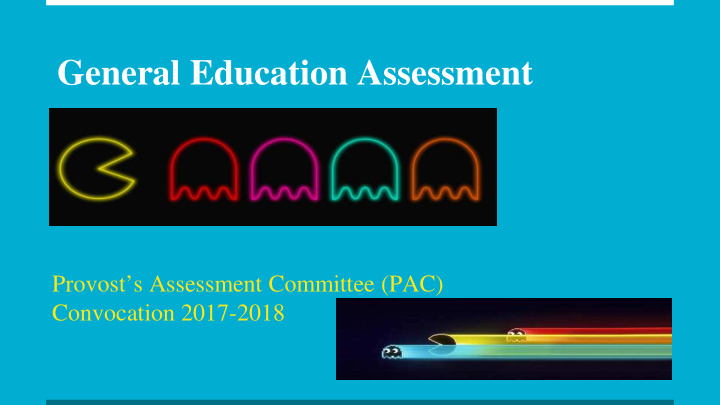



General Education Assessment Provost’s Assessment Committee (PAC) Convocation 2017-2018
GELOs General Education Learning Outcomes Describe knowledge and skills applicable across the entire institution, particularly related to General Education courses.
SLO GELO Vertical Transferability Horizontal Transferability Articulate a course’s role within its Articulate a course’s role within the program (degree/certificate) entire institution Same list of outcomes for all GER courses Different list of outcomes for each course
UAS Core Competencies 1. 1. Com ommuni unication on 2. 2. Quantit itativ ive S Skills ills 3. 3. Inf nfor ormation L on Literacy 4. 4. Inf nfor ormation T on Technol hnolog ogy 5. 5. Prof ofessiona onal B Beha havior or 6. 6. Crit itic ical T l Thin inkin ing
UAS Mission Statement The mission of the University of Alaska Southeast is student learning enhanced by faculty scholarship, undergraduate research and creative activities, community engagement, and the cultures and environment of Southeast Alaska.
UAA’s process UAA started a new assessment process for GERs in AY 16. This included workshops for all faculty on curriculum mapping, rubrics, learning outcomes, assessment, etc. They developed a plan for assessing the student learning outcomes of the GERs that is ongoing (AY16 written communication, oral communication, information literacy; AY17 social sciences, humanities, arts and AY18 quantitative skills, natural sciences and capstone). Similarly, the Associate of Arts degree assessment plan is spread over a 3 year period, addressing 1-2 of the 4 outcomes each year. In AY16-17 they assessed the learning outcome “Communicate effectively”
UAA’s program SLOs for the AA 1) Communicate effectively 2)Think critically 3)Evaluate analytically 4)Reason empirically
Sample assessment rubric from UAA
Task 1: Assessment Plan Define GELOs Develop rubrics to assess Student Learning in GER courses according to GELOs Create assessment templates
Task 2: Assessment Report The Assessment Team, comprised of faculty from a variety of departments, will examine artifacts from a variety of GER courses. Not every course will necessarily address all GELOs. Not every GELO will be assessed across the board at once. The Assessment Team will continue to develop the Assessment Plan and the GELOs.
How to Assess ● Student Artifact: student-created object, such as a written assignment, recorded oral presentation, film, major test ● Specific artifact should be based on specific GELOs ● Artifacts are then rated ● How they are rated depends on the specific assessment approach
Artifact Examples ● Written assignment ● Exam ● Performance/Media ● Portfolios ● Outside-of-class work ● Grades
UAS Example: BASS Student Assessment Portfolio f. Social Science Competency a. Transcript Requirements b. Registrar’s Degree Audit g. One-credit portfolio class (SSCI 210) c. Major Checklist (if applicable) h. Declaration of Graduation d. Program Evaluation Essays i. Resume/Vita e. Diversity Awareness Essays j. Formal Oral Presentation of Portfolio
Draft Timeline Now ow - September 15, 15, 2017 2017 Work with faculty to define UAS GELOs Submit GELOs to Faculty Senate for vote at 10/1 meeting* Sep eptem ember er 1 15 – October 15, 15, 2017 2017 Create draft rubrics for assessing GELOs (based on VALUE rubrics) Enlist appropriate faculty to test/norm draft rubrics Select student artifacts to use for testing/norming draft rubrics * If GELOs don’t pass, use October to revise and push all dates back by one month.
Draft Timeline - continued October 15 15 – November 15, 15, 2017 2017 Faculty group (with PAC team) tests and norms rubrics Novem ember er 1 15 – December 23, 23, 2017 2017 Finalize rubrics Select artifacts to use for actual assessment Enlist appropriate faculty to perform assessment and to write assessment report (call them the “Assessment Group”, or AG for now) Jan anuar ary – May 2018 2018 Faculty group (AG) performs actual assessment and writes assessment report.
Recommend
More recommend